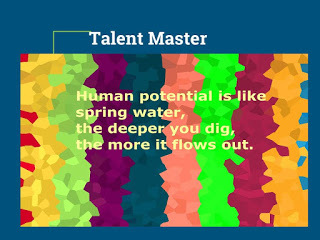Pearl Zhu's Blog, page 1310
August 6, 2016
Apply Discipline to Innovation
 Innovation is how to transform novel ideas to achieve their business values. Innovation management has overall very low success rate. Innovations in the digital era are coming at seemingly much fast space, with changes and potential disruptions, and therefore, innovation management also becomes more complex and dynamic. Innovation is not serendipitous, how to apply discipline to innovation for improving its success rate?
Innovation is how to transform novel ideas to achieve their business values. Innovation management has overall very low success rate. Innovations in the digital era are coming at seemingly much fast space, with changes and potential disruptions, and therefore, innovation management also becomes more complex and dynamic. Innovation is not serendipitous, how to apply discipline to innovation for improving its success rate?
The discipline to manage innovation strategy-implementation continuum: Innovation is a critical component of the business strategy. In general, business innovation is a management discipline. There are three success elements in innovation management: an innovation strategy, a culture to support or even drive innovation, and an innovation management mechanism. The problem is that many organizations do not set the right conditions for the innovation strategy to occur within, something along the lines of the right people with the right mindset in the right roles doing the right work with the right interdependence. Also, innovation strategies don't just require the right tools, the tools are the last piece. In fact, the strategy itself is the last piece prior to implementation. Innovation strategy creates a clear line of sight between the enterprise vision and how to build a balanced portfolio with mixed disruptive innovation and incremental innovation. The innovation strategy is not a thing or even a state, but a process of lining up the culture of change and creativity that people would like to take the calculated risks in experimenting new way to do things, with the business model they create to get it done.
The discipline to manage innovation in a structural way: Applying discipline to innovation is to to figure out how to manage innovation in a structural way. Generally speaking, innovation actions, processes, and tools can be taught to employees. But innovation essential, if you mean technical creativity, originality, insight, ingenuity, etc. can't be taught, but needs to be discovered by talent people on their own. The perspective comes down to how you define innovation. What one person calls innovation, another will say it is a trivial and self-evident step. What one person calls an act of genius, another will treat as unworkable insanity. The right kind of mind is the essential feature of real innovation. Those flashes of inspiration we now see in retrospect as groundbreaking inventions or innovations were driven by people not only far-sighted but determined to make their ideas succeed. Businesses, especially the mature, large corporations and within that environment, innovations can range from small to game changers. Also, it is important to note that within the organizations, innovation is rarely an individual action; rather it is a team effort, often across multiple organizational silos, you need to manage innovation in a structural way via a good alignment of innovators, the disruptive technologies and rigorous, but not rigid processes.
 The discipline to measure innovation via a set of well-defined metrics: You can only manage what you measure, there is no exception for innovation management. There are good reasons to focus on top line vs bottom line benefit from innovation. It’s important to set guidelines for developing customized innovation metrics. Select the few (3-5) KPIs, to keep the measures simple and understandable.The innovation metrics in the context of business impact include such as, % of revenue from new products or services. You could also change the variables and create something like % of the profit from new ideas implemented. Some choose innovation process KPIs, which could link to strategy, to make progress on the percentage of projects in the total innovation portfolio which contained a major part of external innovation. All innovation initiatives, hopefully, are started to achieve some business result directly or indirectly. Just measure that result objectively and effectively, more than to measure financial results. And always keep the measurement simple, understandable and understandable.
The discipline to measure innovation via a set of well-defined metrics: You can only manage what you measure, there is no exception for innovation management. There are good reasons to focus on top line vs bottom line benefit from innovation. It’s important to set guidelines for developing customized innovation metrics. Select the few (3-5) KPIs, to keep the measures simple and understandable.The innovation metrics in the context of business impact include such as, % of revenue from new products or services. You could also change the variables and create something like % of the profit from new ideas implemented. Some choose innovation process KPIs, which could link to strategy, to make progress on the percentage of projects in the total innovation portfolio which contained a major part of external innovation. All innovation initiatives, hopefully, are started to achieve some business result directly or indirectly. Just measure that result objectively and effectively, more than to measure financial results. And always keep the measurement simple, understandable and understandable.Applying discipline to innovation is to better align innovation management with strategy, to justify the initial investment in the program and the initial results, setting principle for innovation management and measurement, cultivate a culture of change and creativity, develop the best and next practice in idea management and process management, and keep the ends in mind - to grow businesses and achieve high performance business result for long term.Follow us at: @Pearl_Zhu
Published on August 06, 2016 23:14
August 5, 2016
The Monthly Insight: Five Big “HOW”s in Change Management Aug. 2016
 Change is inevitable, organizational change has become a common practice within an organization, but too often changes are made as a reaction to outer impulses, crisis, and demands. This is the bureaucracy’s way of meeting the challenges. How to understand the mentalities behind the change as the first step, in order to fine tune the process of Change Management, and overcome the obstacles to managing a digital transformation smoothly, and what other “HOW’s to figure out how to manage change effectively?
Change is inevitable, organizational change has become a common practice within an organization, but too often changes are made as a reaction to outer impulses, crisis, and demands. This is the bureaucracy’s way of meeting the challenges. How to understand the mentalities behind the change as the first step, in order to fine tune the process of Change Management, and overcome the obstacles to managing a digital transformation smoothly, and what other “HOW’s to figure out how to manage change effectively?
Five Big “HOW”s in Change Management How Capable is your Organization Handling Changes: Change becomes fundamentally difficult in most organizations because it is treated as something distinct from running the business, evolving performance and increasing results over time. Leaders and employees are stressed enough in getting done what is right in front of them that change is layered upon becomes disruptive. However, the accelerating speed of change, the volatile and uncertain business environment make the change as an ongoing capability organizations must master, so in which aspects the business should focus on to building its change ‘muscles’?
How to Breakdown Bureaucracies in Digital Transformation: Digital is about changes, closer to reality is that 'change' is continuously happening in such a dynamic environment of a company. The desires of stakeholders, clients and employees are evolving naturally, not to mention that many of organizations today are facing a more radical digital transformation. What is the digital leadership all about, how to cultivate digital attitudes to break down bureaucracies in accelerating digital transformation in organizations or our society?
How Much do Senior Leaders need to support Change Management? Change is a volatile subject, just like change itself. Everything changes continuously by following the laws of evolution, and the rate of change is accelerated. Corporate change can be a simple modification of strategy, a business process improvement or a more radical digital transformation. Generally speaking, how much do senior leaders need to support Change Management?
How to Mentor Human Side of Business via Change Management: Change for all of us is inevitable, some of us get it quicker than others. So the challenge for organizations is to recognize who their people are and where these talent professionals can contribute to the business success and feel valued along the way. From change management perspective, what’re the psychology behind the change? What are the principles to manage change? What would be a good way to empower change capabilities? And how to mentor human side of business via Change Management?
 How to Assess and Improve Change Management Maturity? Change is inevitable and needed in every business. But organizational Change Management is always challenging with a high percentage of failure rate. The successful businesses are the ones that have learned how to implement change time after time, and build it as a solid ongoing business capability. Change Management requires a well-defined strategy with comprehensive change agenda as well. Is there any ideal route for the change, and how to improve the success rate of Change Management and improve overall Change Management maturity?
How to Assess and Improve Change Management Maturity? Change is inevitable and needed in every business. But organizational Change Management is always challenging with a high percentage of failure rate. The successful businesses are the ones that have learned how to implement change time after time, and build it as a solid ongoing business capability. Change Management requires a well-defined strategy with comprehensive change agenda as well. Is there any ideal route for the change, and how to improve the success rate of Change Management and improve overall Change Management maturity?Blogging is not about writing, but about thinking; it’s not just about WHAT to say, but about WHY to say, and HOW to say it. It reflects the color and shade of your thought patterns, and it indicates the peaks and curves of your thinking waves. Unlike pure entertainment, quality and professional content takes time for digesting, contemplation and engaging, and therefore, it takes the time to attract the "hungry minds" and the "deep souls." It’s the journey to amplify your voice, deepen your digital footprints, and match your way for human progression.Follow us at: @Pearl_Zhu
Published on August 05, 2016 23:19
"CIO Master" Book Tuning: XXXXXVIIII: Three Dimensions of IT Digital Transformation
The digital world is so data-driven and information-intensive, technology needs will only expand, and most likely expand hyperbolically.
 IT plays a more significant role in the digital transformation of the organization, It has to accelerate its speed and amplify its impact from a silo function to an integral strategic partner, from a support desk to an innovation engine, and from an order taker to a strategy co-maker. Unfortunately, more than two-thirds of changes and business transformations fail to achieve the expectation. Running IT as a change organization, how can CIOs drive such a multidimensional digital transformation effortlessly?
IT plays a more significant role in the digital transformation of the organization, It has to accelerate its speed and amplify its impact from a silo function to an integral strategic partner, from a support desk to an innovation engine, and from an order taker to a strategy co-maker. Unfortunately, more than two-thirds of changes and business transformations fail to achieve the expectation. Running IT as a change organization, how can CIOs drive such a multidimensional digital transformation effortlessly?
Envisioning and communicating to drive a People-centric digital transformation: The reason why many business transformations fail - some soft factors and the challenge of complexity come into play. It’s about the vision to change and effective communication to get the people buy-in. Hence, the CIO as an IT leader should be a productive member and provide some active insight and options. More to the point, without the analysis, insight and understanding of the CIO, how does any C-executive direct the creation of a business strategy that is increasingly dependent on technology and, competitive advantages that derive from the technology. Forward-looking organizations are empowering their CIOs to lead at the front, hence, CIOs require being confident to create and manage changes. It requires a leadership substance of vision and style that more closely matches the thought leadership practices and action-oriented style of top executives. CIOs need to be good “interpreters,” be fluent both business language and IT dialect. For any level or type of communication, mutual respect is the right attitude. A good ‘interpreter’ is not only about translating the content of the conversation but being cognizant of the tones and contextual intelligence, value multiple perspectives with respect to makes positive influence upon pulling a progressive conversation ahead for leading change effectively.
Business benefits and value articulation: Most IT organizations are still treated as the cost centers of the business. In order to improve its maturity, articulating business benefits and value is an important step in refining digital IT. In order to demonstrate IT value, organizations need to first know wherein lies the IT value. If you understand that upfront by doing the right strategic questioning, you can later go back and ask if you achieved the value that had been set out to attain. Broadly speaking, IT is about getting the right information to the right people to make the right decisions at the right time; it’s about distributing and sharing intelligence on the scale, and assisting business, social and lifestyle and purpose needs, uniformly, fairly and effectively. More specifically, IT leaders can lead further via inquiries: (1) How does IT become strategic? and (2) How does IT deliver maximum value? The value itself is a multi-dimensional concept, a seamless customer experience, an optimal business service, a commercial value proposition, a social value system which deals with and provides context for varying interest and need. Looking at it from the point of view of "What's in it for me?" The business would like to know what's in it for them. So the IT needs to first understand what the business is, what their pain points are, identify areas for improvement and those that can be improved with IT. From the strategic leadership perspective, where IT needs to provide a strategic advantage to the business line manager; where IT needs to make the function more productive, and ultimately improve overall business agility and maturity.
 Organizational structure tuning and a balanced program portfolio building: To drive digital transformation, the organization also has to continue to re-imagine, reinvent and reshuffle itself to adapt to the changes, have better focus to execute what is needed of them. The organization needs to be realigned to ensure the right people are in the right positions; The focus of duties makes it much simpler to hire and scale the organization as business rapidly grow. The structure has to allow for agility and change, as the business grows and evolves. You need to also ensure, technology is providing a new innovation function or service, to look at new areas and new ideas for business growth. The objective of digital business is to break down silo walls and utilize the human potential of continuous improvement for a more people-centric reorganization. The wins achieved by the cross-functional teams have a positive impact on business-side perceptions of IT as well as providing a sense of success often missing in many IT organizations. The main objective is to lay the foundation for strategy execution via managing a balanced program portfolio closely aligned with the business model and capabilities.
Organizational structure tuning and a balanced program portfolio building: To drive digital transformation, the organization also has to continue to re-imagine, reinvent and reshuffle itself to adapt to the changes, have better focus to execute what is needed of them. The organization needs to be realigned to ensure the right people are in the right positions; The focus of duties makes it much simpler to hire and scale the organization as business rapidly grow. The structure has to allow for agility and change, as the business grows and evolves. You need to also ensure, technology is providing a new innovation function or service, to look at new areas and new ideas for business growth. The objective of digital business is to break down silo walls and utilize the human potential of continuous improvement for a more people-centric reorganization. The wins achieved by the cross-functional teams have a positive impact on business-side perceptions of IT as well as providing a sense of success often missing in many IT organizations. The main objective is to lay the foundation for strategy execution via managing a balanced program portfolio closely aligned with the business model and capabilities.
The digital world is so data-driven and information-intensive, technology needs will only expand, and most likely expand hyperbolically. Digital IT should be more robust and antifragile than ever. IT and the overall business digital transformation is multidimensional. IT just needs to adjust to the digital speed, be wired (or wireless) to change, and take a leadership role in navigating digital transformation. IT should play even more crucial roles as a service broker, a customer solutionary, value-creator, and a digital orchestrator.
CIO Master Order Link on Amazon CIO Master Ordre Link on Barner & Noble CIO Master Order Link On IBooks “CIO Master” Book Preview Quote Collection III “CIO Master” Book Preview Quote Collection II “CIO Master” Book Preview Quote Collection I, Slideshare Presentation “CIO Master” Book Preview Conclusion Running IT as Digital Transformer “CIO Master” Book Preview: Chapter 9 IT Agility “CIO Master” Book Preview: Chapter 8 Three "P"s in Running Digital IT “CIO Master” Book Preview: Chapter 7 IT Innovation Management “CIO Master” Book Preview: Chapter 6 Digital Strategy-Execution Continuum "CIO Master” Book Preview: Chapter 5 Thirteen Digital Flavored IT “CIO Master” Book Preview: Chapter 4 CIO as Talent Master Introduction “CIO Master” Book Preview: Chapter 3 “CIOs as Change Agent” Introduction “CIO Master” Book Preview: Chapter 2 “CIOs as Digital Visionary” Introduction “CIO Master” Book Preview: Chapter 1 “Twelve Digital CIO Personas” Introduction "CIO Master - Unleash the Digital Potential of IT" Introduction "CIO Master - Unleash the Digital Potential of IT" Book Preview
Follow us at: @Pearl_Zhu
 IT plays a more significant role in the digital transformation of the organization, It has to accelerate its speed and amplify its impact from a silo function to an integral strategic partner, from a support desk to an innovation engine, and from an order taker to a strategy co-maker. Unfortunately, more than two-thirds of changes and business transformations fail to achieve the expectation. Running IT as a change organization, how can CIOs drive such a multidimensional digital transformation effortlessly?
IT plays a more significant role in the digital transformation of the organization, It has to accelerate its speed and amplify its impact from a silo function to an integral strategic partner, from a support desk to an innovation engine, and from an order taker to a strategy co-maker. Unfortunately, more than two-thirds of changes and business transformations fail to achieve the expectation. Running IT as a change organization, how can CIOs drive such a multidimensional digital transformation effortlessly?
Envisioning and communicating to drive a People-centric digital transformation: The reason why many business transformations fail - some soft factors and the challenge of complexity come into play. It’s about the vision to change and effective communication to get the people buy-in. Hence, the CIO as an IT leader should be a productive member and provide some active insight and options. More to the point, without the analysis, insight and understanding of the CIO, how does any C-executive direct the creation of a business strategy that is increasingly dependent on technology and, competitive advantages that derive from the technology. Forward-looking organizations are empowering their CIOs to lead at the front, hence, CIOs require being confident to create and manage changes. It requires a leadership substance of vision and style that more closely matches the thought leadership practices and action-oriented style of top executives. CIOs need to be good “interpreters,” be fluent both business language and IT dialect. For any level or type of communication, mutual respect is the right attitude. A good ‘interpreter’ is not only about translating the content of the conversation but being cognizant of the tones and contextual intelligence, value multiple perspectives with respect to makes positive influence upon pulling a progressive conversation ahead for leading change effectively.
Business benefits and value articulation: Most IT organizations are still treated as the cost centers of the business. In order to improve its maturity, articulating business benefits and value is an important step in refining digital IT. In order to demonstrate IT value, organizations need to first know wherein lies the IT value. If you understand that upfront by doing the right strategic questioning, you can later go back and ask if you achieved the value that had been set out to attain. Broadly speaking, IT is about getting the right information to the right people to make the right decisions at the right time; it’s about distributing and sharing intelligence on the scale, and assisting business, social and lifestyle and purpose needs, uniformly, fairly and effectively. More specifically, IT leaders can lead further via inquiries: (1) How does IT become strategic? and (2) How does IT deliver maximum value? The value itself is a multi-dimensional concept, a seamless customer experience, an optimal business service, a commercial value proposition, a social value system which deals with and provides context for varying interest and need. Looking at it from the point of view of "What's in it for me?" The business would like to know what's in it for them. So the IT needs to first understand what the business is, what their pain points are, identify areas for improvement and those that can be improved with IT. From the strategic leadership perspective, where IT needs to provide a strategic advantage to the business line manager; where IT needs to make the function more productive, and ultimately improve overall business agility and maturity.
 Organizational structure tuning and a balanced program portfolio building: To drive digital transformation, the organization also has to continue to re-imagine, reinvent and reshuffle itself to adapt to the changes, have better focus to execute what is needed of them. The organization needs to be realigned to ensure the right people are in the right positions; The focus of duties makes it much simpler to hire and scale the organization as business rapidly grow. The structure has to allow for agility and change, as the business grows and evolves. You need to also ensure, technology is providing a new innovation function or service, to look at new areas and new ideas for business growth. The objective of digital business is to break down silo walls and utilize the human potential of continuous improvement for a more people-centric reorganization. The wins achieved by the cross-functional teams have a positive impact on business-side perceptions of IT as well as providing a sense of success often missing in many IT organizations. The main objective is to lay the foundation for strategy execution via managing a balanced program portfolio closely aligned with the business model and capabilities.
Organizational structure tuning and a balanced program portfolio building: To drive digital transformation, the organization also has to continue to re-imagine, reinvent and reshuffle itself to adapt to the changes, have better focus to execute what is needed of them. The organization needs to be realigned to ensure the right people are in the right positions; The focus of duties makes it much simpler to hire and scale the organization as business rapidly grow. The structure has to allow for agility and change, as the business grows and evolves. You need to also ensure, technology is providing a new innovation function or service, to look at new areas and new ideas for business growth. The objective of digital business is to break down silo walls and utilize the human potential of continuous improvement for a more people-centric reorganization. The wins achieved by the cross-functional teams have a positive impact on business-side perceptions of IT as well as providing a sense of success often missing in many IT organizations. The main objective is to lay the foundation for strategy execution via managing a balanced program portfolio closely aligned with the business model and capabilities.
The digital world is so data-driven and information-intensive, technology needs will only expand, and most likely expand hyperbolically. Digital IT should be more robust and antifragile than ever. IT and the overall business digital transformation is multidimensional. IT just needs to adjust to the digital speed, be wired (or wireless) to change, and take a leadership role in navigating digital transformation. IT should play even more crucial roles as a service broker, a customer solutionary, value-creator, and a digital orchestrator.
CIO Master Order Link on Amazon CIO Master Ordre Link on Barner & Noble CIO Master Order Link On IBooks “CIO Master” Book Preview Quote Collection III “CIO Master” Book Preview Quote Collection II “CIO Master” Book Preview Quote Collection I, Slideshare Presentation “CIO Master” Book Preview Conclusion Running IT as Digital Transformer “CIO Master” Book Preview: Chapter 9 IT Agility “CIO Master” Book Preview: Chapter 8 Three "P"s in Running Digital IT “CIO Master” Book Preview: Chapter 7 IT Innovation Management “CIO Master” Book Preview: Chapter 6 Digital Strategy-Execution Continuum "CIO Master” Book Preview: Chapter 5 Thirteen Digital Flavored IT “CIO Master” Book Preview: Chapter 4 CIO as Talent Master Introduction “CIO Master” Book Preview: Chapter 3 “CIOs as Change Agent” Introduction “CIO Master” Book Preview: Chapter 2 “CIOs as Digital Visionary” Introduction “CIO Master” Book Preview: Chapter 1 “Twelve Digital CIO Personas” Introduction "CIO Master - Unleash the Digital Potential of IT" Introduction "CIO Master - Unleash the Digital Potential of IT" Book Preview
Follow us at: @Pearl_Zhu
Published on August 05, 2016 23:16
Three Dimensions of IT Digital Transformation
 IT plays a more significant role in the digital transformation of the organization, It has to accelerate its speed and amplify its impact from a silo function to an integral strategic partner, from a support desk to an innovation engine, and from an order taker to a strategy co-maker. Unfortunately, more than two-thirds digital transformation fail to achieve its expectation. How can CIOs drive such a multidimensional digital transformation effortlessly?
IT plays a more significant role in the digital transformation of the organization, It has to accelerate its speed and amplify its impact from a silo function to an integral strategic partner, from a support desk to an innovation engine, and from an order taker to a strategy co-maker. Unfortunately, more than two-thirds digital transformation fail to achieve its expectation. How can CIOs drive such a multidimensional digital transformation effortlessly?
Envisioning and communicating to drive a People-centric digital transformation: The reason why many transformations fail - some soft factors and the challenge of complexity come into play. It’s about the vision to change and effective communication to get the people buy-in. Hence, the CIO as an IT leader should be a productive member and provide some active insight and options. More to the point, without the analysis, insight and understanding of the CIO, how does any C-executive direct the creation of a business strategy that is increasingly dependent on technology and, competitive advantages that derive from the technology. Forward-looking organizations are empowering their CIOs lead at the front, hence, CIOs require being confident to create and manage changes. It requires a leadership substance of vision and style that more closely matches the thought leadership substance and action-oriented style of senior executives. CIOs need to be good “interpreters,” be fluent both business language and IT dialect. For any level or type of communication, mutual respect is the right attitude. A good ‘interpreter’ is not only about translating the content of the conversation but being cognizant of the tones and contextual intelligence, value multiple perspectives with respect to makes positive influence upon pulling a progressive conversation ahead for leading change effectively.
Business benefits and value articulation: Most IT organizations are still treated as the cost center of the business. In order to improve its maturity, articulating business benefits and value is an important step in refining digital IT. In order to demonstrate IT value, organizations need to first know wherein lies the IT value. If you understand that upfront by doing the right strategic questioning, you can later go back and ask if you achieved the value that had been set out to attain. Broadly speaking, IT is about getting the right information to the right people to make the right decisions at the right time; it’s about distributing and sharing intelligence on the scale, and assisting business, social and lifestyle and purpose needs, uniformly, fairly and effectively. More specifically, IT leaders can lead further via inquiries: (1) How does IT become strategic? and (2) How does IT deliver maximum value? The value itself is a multi-dimensional concept, a seamless customer experience, an optimal business service, a commercial value proposition, a social value system which deals with and provides context for varying interest and need. Looking at it from the point of view of "What's in it for me?" The business would like to know what's in it for them. So the IT needs to first understand what the business is, what their pain points are, identify areas for improvement and those that can be improved with IT. From the strategic leadership perspective, where IT needs to provide a strategic advantage to the business line manager; where IT needs to make the function more productive, and ultimately improve overall business agility and maturity.
 Organizational structure tuning and a balanced program portfolio building: To drive digital transformation, the organization also has to continue to re-imagine, reinvent and reshuffle itself to adapt to the changes. have better focus to execute what is needed of them. The organization needs to be realigned to ensure the right people are in the right positions; The focus of duties makes it much simpler to hire and scale the organization as business rapidly grow. The structure has to allow for agility and change, as the business grows and evolves. You need to also ensure, technology is providing a new innovation function or service, to look at new areas and new ideas, for business growth. The objective of digital business is to break down silo walls and utilize the human potential of continuous improvement for a more people-centric reorganization. The wins achieved by the cross-functional teams have a positive impact on business-side perceptions of IT as well as providing a sense of success often missing in many IT organizations. The main objective is to lay the foundation for strategy execution via managing a balanced program portfolio closely aligned with the business model and capabilities.
Organizational structure tuning and a balanced program portfolio building: To drive digital transformation, the organization also has to continue to re-imagine, reinvent and reshuffle itself to adapt to the changes. have better focus to execute what is needed of them. The organization needs to be realigned to ensure the right people are in the right positions; The focus of duties makes it much simpler to hire and scale the organization as business rapidly grow. The structure has to allow for agility and change, as the business grows and evolves. You need to also ensure, technology is providing a new innovation function or service, to look at new areas and new ideas, for business growth. The objective of digital business is to break down silo walls and utilize the human potential of continuous improvement for a more people-centric reorganization. The wins achieved by the cross-functional teams have a positive impact on business-side perceptions of IT as well as providing a sense of success often missing in many IT organizations. The main objective is to lay the foundation for strategy execution via managing a balanced program portfolio closely aligned with the business model and capabilities.
The digital world is so data-driven and information-intensive, technology needs will only expand, and most likely expand hyperbolically. Digital IT should be more robust and antifragile than ever. IT and the overall business digital transformation is multidimensional. IT just needs to adjust to the digital speed, be wired (or wireless) to change, and take a leadership role in navigating digital transformation. IT should play even more crucial roles as a service broker, a customer solutionary, value-creator, and a digital orchestrator.
Follow us at: @Pearl_Zhu
Published on August 05, 2016 23:16
August 4, 2016
The Weekly Insight of the “Future of CIO” 8/5/2016
 The “Future of CIO” Blog has reached 1.5 million page views with 3000+ blog posting in 59+ different categories of leadership, management, strategy, digitalization, change/talent, etc. The content richness is not for its own sake, but to convey the vision and share the wisdom. Here is the weekly insight about digital leadership, IT Management, and Talent Management.
The “Future of CIO” Blog has reached 1.5 million page views with 3000+ blog posting in 59+ different categories of leadership, management, strategy, digitalization, change/talent, etc. The content richness is not for its own sake, but to convey the vision and share the wisdom. Here is the weekly insight about digital leadership, IT Management, and Talent Management.
The Weekly Insight of the “Future of CIO” 8/5/2016To Celebrate the 3000th Blog Posting of “Future of CIO” with 1.5 Million Worldwide Views: Blogging is to pursue the digital communication way for envisioning, brainstorming, sharing, debating, and making a continuous delivery for practicing thought leadership and spurring innovation. It’s not just about writing, but about thinking. The content richness is not for its own sake, but to convey the vision and share the wisdom. Here comes the 3000th blog posting of the "Future of CIO." if writing a book is 1% of inspiration plus 99% of perspiration, and then creating & producing blogs takes 5% (inspiration + creativity) plus 95% of (dedication + perseverance).
Running IT as a Niche Player Digital provides significant opportunities for business growth and innovation, and IT plays a significant role in digital transformation. That means IT has to reinvent its brand from a cost center to a value creator; from an order taker to an idea shaker, and from a commodity service provider to an innovation engine and digital whole brain. But more specifically, what are perspectives to run IT as a niche player?
 The Multiple Confusions to Drag Down Digital Leadership Effectiveness Leadership is all about change, to navigate the direction both for oneself and others. The digital world today is much more complicated and that requires an ability to juggle multiple and competing demands and clear the vision under cloudy climate and uncertain circumstances. Businesses need to recognize the change and help leaders meet the challenge via business savvy and agility. In reality, there are many well trained transactional managers, but very few visionary transformational digital leaders; there are many skillful communicators, but very few deep and original thinkers. Under today's uncertainty and ambiguity as the digital new normal, what are possible confusions to drag down leadership effectiveness and how to improve overall digital leadership maturity?
The Multiple Confusions to Drag Down Digital Leadership Effectiveness Leadership is all about change, to navigate the direction both for oneself and others. The digital world today is much more complicated and that requires an ability to juggle multiple and competing demands and clear the vision under cloudy climate and uncertain circumstances. Businesses need to recognize the change and help leaders meet the challenge via business savvy and agility. In reality, there are many well trained transactional managers, but very few visionary transformational digital leaders; there are many skillful communicators, but very few deep and original thinkers. Under today's uncertainty and ambiguity as the digital new normal, what are possible confusions to drag down leadership effectiveness and how to improve overall digital leadership maturity?
Digital CIOs’ Elevator Pitch: Digital IT plays a significant role in business transformation. CIOs as IT leaders also have to envision and convey the clear message about IT reputation. So what's CIO's elevator pitch for getting BoDs, executive peers, and shareholders' buy-in?
Three Barriers to Change Management: Change is inevitable, and the speed of change is increasing. How capable the business is handling change would directly impact on the business competency. However, there is a high failure rate of Change Management statistically. What are the big barriers and how to craft change as an ongoing capability?Blogging is not about writing, but about thinking and innovating the new ideas; it’s not just about WHAT to say, but about WHY to say, and HOW to say it. It reflects the color and shade of your thought patterns, and it indicates the peaks and curves of your thinking waves. Unlike pure entertainment, quality and professional content takes time for digesting, contemplation and engaging, and therefore, it takes the time to attract the "hungry minds" and the "deep souls." It’s the journey to amplify diverse voices and deepen digital footprints, and it's the way to harness your innovative spirit.
Follow us at: @Pearl_Zhu
Published on August 04, 2016 23:04
CIOs as Chief Innovation Officer: What’re your Perceptions and Actions to Rejuvenate Innovation
 Innovation can happen everywhere - it is our gift as humans - a great deal of what defines us as humans actually. whether new products, services, solutions, new sounds and music, new way of reading and publishing, new ways of educating future of generation, etc From business perspective, innovation is the mechanism through which you grow and evolve something to something great (higher value-add or ever breakthrough) or something new or better based on a combination or modification of previous attributes/approaches. Businesses, especially the mature, large corporations and within that environment, innovations can range from small to game changers. Also, it is important to note that within the organizations, innovation is rarely an individual action; rather it is a team effort, often across multiple organizational silos. What are perceptions and actions to rejuvenate innovation in a traditional organization?
Innovation can happen everywhere - it is our gift as humans - a great deal of what defines us as humans actually. whether new products, services, solutions, new sounds and music, new way of reading and publishing, new ways of educating future of generation, etc From business perspective, innovation is the mechanism through which you grow and evolve something to something great (higher value-add or ever breakthrough) or something new or better based on a combination or modification of previous attributes/approaches. Businesses, especially the mature, large corporations and within that environment, innovations can range from small to game changers. Also, it is important to note that within the organizations, innovation is rarely an individual action; rather it is a team effort, often across multiple organizational silos. What are perceptions and actions to rejuvenate innovation in a traditional organization?
Mind innovation gaps substantially: Different organizations have different strengths and capability to innovate, innovative skills and capabilities an organization always needs depend on the circumstances the business is in. At the stage of idea creation, to minding innovation gaps, the diverse team with cognitive differences is more successful and is always going to be more creative as it has more to draw on. The gap between the discovery, driving, and delivery driven management are critical and often leads to conflicts, deluding the transfer. Many companies form and grow on the basis of "idea creation," but then get bogged down when trying to "commercialize" those ideas, because it requires a different skill set, focus, and even a needed passion. If a company's focus swings too far to the commercialization side of the equation, then innovation suffers and vice-versa. Innovation comes with a risk of failure, usually not well tolerated in a market governed by risk-allergic mindset. Or, when business leaders, goes beyond short-term gain, take a calculated risk and make a long-term investment, organizations have a better opportunity to shift from surviving to thriving mode. Innovation is about moving forward. In any business, if you are not moving forward, you are moving backward. There is no standing still. Companies have to be prepared to lose some to gain more for the longer term.
Reward risk-taking to build a culture of innovation: In essence, innovation rejuvenation is truly about culture rejuvenation. Most of the innovative organizations are headed by innovative leaders with original ideas, who can see, understand and appreciate the merits of people who can think differently. The culture of innovation starts with a culture of participation because employee engagement in the innovation process increases participation. The failures should not be rewarded, but they should be understood and not penalized. And surely the risk taking also should be supported - morally at least. It’s about rejuvenating a "culture of innovation" which incorporates multiple and diverse components. It doesn't mean you should reward "failure" as such; but to inspire the culture of innovation, you should rather reward taking risks.
 Managing a healthy innovation portfolio via understanding the ^Depth + ^Breadth = ^Probability for innovation: Nowadays there is a digital convenience of being innovative. Lots of tools are available to help us think differently, assess problems and come to solutions in novel ways. When looking at business/ organizations, the most powerful of these processes involves tapping the organization's ecosystem (people!) for the collective perspectives/insights of those who make up and know intimately their parts of the system. The innovation spectrum is also expanded, businesses need to have capabilities to manage both breakthrough innovations and incremental innovation well. Innovative ideas are one thing, execution is a whole different matter. The fact is that the business has tried to be innovative in some capacity. Products have consistently been designed to solve a problem, the best companies sometimes "create" problems that people didn't even know existed then solve them. Innovation is not only externally oriented (relative to markets, customers, consumers) but can also be focused on the operations side (within a firm as well as industry structure). The Depth & Breadth understanding of the digital ecosystem would help to connect nonlinear dots to a better probability for innovation.
Managing a healthy innovation portfolio via understanding the ^Depth + ^Breadth = ^Probability for innovation: Nowadays there is a digital convenience of being innovative. Lots of tools are available to help us think differently, assess problems and come to solutions in novel ways. When looking at business/ organizations, the most powerful of these processes involves tapping the organization's ecosystem (people!) for the collective perspectives/insights of those who make up and know intimately their parts of the system. The innovation spectrum is also expanded, businesses need to have capabilities to manage both breakthrough innovations and incremental innovation well. Innovative ideas are one thing, execution is a whole different matter. The fact is that the business has tried to be innovative in some capacity. Products have consistently been designed to solve a problem, the best companies sometimes "create" problems that people didn't even know existed then solve them. Innovation is not only externally oriented (relative to markets, customers, consumers) but can also be focused on the operations side (within a firm as well as industry structure). The Depth & Breadth understanding of the digital ecosystem would help to connect nonlinear dots to a better probability for innovation.
Innovation, as an individual process or collective processes, helps us adapt, improve, grow and integrate. The art of innovation is that it involves new ways of bringing together ideas and resources to create something novel. Identification of the novel is only the beginning, the heavy lifting starts as a firm aligns resources and executes, and the science of innovation is to manage innovation life cycle and executes in a systematic manner that provides sustained competitive advantage.
Follow us at: @Pearl_Zhu
Published on August 04, 2016 22:59
August 3, 2016
To Celebrate the 3000th Blog Posting of “Future of CIO” with 1.5 Million Worldwide Views: Blogging as a Digital Communication Way for Continuous Delivery
Blogging is 5% of inspiration +creativity with 95% of dedication + perseverance.
 Blogging is to pursue the digital communication way for envisioning, brainstorming, sharing, debating, and making a continuous delivery for practicing thought leadership and spurring innovation. It’s not just about writing, but about thinking. The content richness is not for its own sake, but to convey the vision and share the wisdom. Here comes the 3000th blog posting of the "Future of CIO." if writing a book is 1% of inspiration plus 99% of perspiration, and then creating & producing blogs takes 5% (inspiration + creativity) plus 95% of (dedication + perseverance).
Blogging is to pursue the digital communication way for envisioning, brainstorming, sharing, debating, and making a continuous delivery for practicing thought leadership and spurring innovation. It’s not just about writing, but about thinking. The content richness is not for its own sake, but to convey the vision and share the wisdom. Here comes the 3000th blog posting of the "Future of CIO." if writing a book is 1% of inspiration plus 99% of perspiration, and then creating & producing blogs takes 5% (inspiration + creativity) plus 95% of (dedication + perseverance).
To Celebrate the 3000th Blog Posting Slideshare
-Imagining the blog is a growing tree with 3000+ fruits blossom, not for decoration, but for innovation;
Imagining the blog is the knowledge power made of 3000+ building blocks, mightier than the magic bullets, to remove the barriers and overcome bias, not for winning, but for progression;
Imagining the blog is like the spring water with 3000+ creativity fountains merged in, the deeper you dig, the more it flows out;
Imagining the blog is a brainstorming or "thinking shower" with 3 billion+ mind connections, to clean up the dust and fresh the surroundings;
 -Imagine the blog is a dynamic book with 3000+ pages and continue to add on, it will never end if the vision is not fulfilled and the audience is not satisfied.
-Imagine the blog is a dynamic book with 3000+ pages and continue to add on, it will never end if the vision is not fulfilled and the audience is not satisfied.
Imagine, Imagine, and Imagine more! The blog is the means to the end; the end is to discover who you are, participate in problem solving, inspire creativity, advocate digital mind fit and push the human world forward with harmony!
The “Future of CIO” Blog Highlights with Featured Categories Envision the future of leadership, information management, innovation, talent management and further. Vision is a foresight with a proactive understanding of cause and effect, not reactive seeing. It is a clear choice among future scenarios that advocates future trends and promotes certain behavior.
Future of Leadership: Leadership is all about future and change. Leadership vision is to serve as an enabler to make profound influences; to practice Thought Leadership for making a profound influence. To clear the path, whether that be the elimination of obstacles or to provide coaching and guidance and make an influence so that the talent employees are limited only by their imagination.
All about the future: A visionary mind has the ability to think the past, perceive what is now and foresee the future. The past can't see you, but the future is listening. - Destin Figuier
CIO Leadership: Digital CIOs have many personas indicated in the “I” of the CIO title: Chief information officer, Chief Interpretation Officer, Chief Intelligence Officer, Chief Interaction Officer, Chief Infrastructure Officer, Chief Integration Officer, chief International officer, Chief Inspiration Officer, Chief Innovation Officer, Chief Influence Office etc. “Chief Innovation Officer” is one of the most pertinent roles they need to fulfill. A great CIO with their finger on the pulse of technological advancement or information insight can provide many ideas on how new technology and abundance of information can create fresh new opportunities.
Inspire Creativity -to share “out of box” thinking with the audacity to convey in a professional way. Creativity is about thinking beyond conventional wisdom, or the “Out of Box” thinking. Creative state of mind means many things, it’s an open mind to continue learning and discovering; it’s a possible mind to think in a positive way and make impossible possible; it’s a desirable mind to transform inward driven creativity into outward driven innovation, and it’s a disruptive mind to break down silos and convey different perspectives because the real learning is always a rebellion.
Digital Innovation: Innovation is one of the focal points of the “Future of CIO” blog. Innovation is the development of a new combination of available resources, in a way that solves real world problems in a more suitable way. The challenge is always about how to manage risk, build a healthy innovation portfolio, leverage resources, set priorities right and take steady pace to improve innovation success rate.
 Talent Management: Creativity is #1 wanted quality for digital leaders and professionals nowadays, but where can you discover innovators? Do innovators belong to rare breed or they are among us and within us? Why can innovators find more view spots than others? Why can innovators think differently via connecting unusual dots? What are important traits of innovators?
Talent Management: Creativity is #1 wanted quality for digital leaders and professionals nowadays, but where can you discover innovators? Do innovators belong to rare breed or they are among us and within us? Why can innovators find more view spots than others? Why can innovators think differently via connecting unusual dots? What are important traits of innovators?
IT Transformation: Nowadays, at the dawn of the Digital Era, information is one of the most valuable business assets and technologies are disruptive forces behind the digital transformation. How to run a digital IT from “Outside-In,” as an innovation engine, customer advocate, and a business differentiator?
Present multidimensional intelligence -To see things from different angles. Digital disruption is frequent and unstructured, businesses just have to get used to the new normal and learn how to deal with them proactively.
Decision Making: Making a decision is one of the most significant tasks for business leaders and digital professionals. However, the high ratio of strategic decisions has been made poorly and cause the catastrophic effect. What are the magic formulas to make effective decisions?
Digital Master: In the world where everything is touched by digital technologies, businesses across sectors are on the journey to digital transformation, they should not just include the digital aspects of strategy to their strategic plans, but think deep on how to reshape the digital version of the corporate strategy management
Learning from failures: Like many other things in business, it is a balancing act to have enough failure and an environment that encourages learning from failure quickly and cheaply, without having failures that are too frequent or too expensive. Ultimately it is critical that innovation results in financial successes or a business will not remain competitive.
It’s time to celebrate 3000 blogs posting with 1.5 worldwide views! Imagine they can remove 3000+ heavy roadblocks or hidden barriers, visible obstacles or invisible pitfalls...Blogging is not about writing, but about thinking and innovating the new ideas; it’s not just about WHAT to say, but about WHY to say, and HOW to say it. It reflects the color and shade of your thought patterns, and it indicates the peaks and curves of your thinking waves. Unlike pure entertainment, quality and professional content takes time for digesting, contemplation and engaging, and therefore, it takes the time to attract the "hungry minds" and the "deep souls." It’s the journey to amplify diverse voices and deepen digital footprints, and it's the way to harness our innovative spirit.
Follow us at: @Pearl_Zhu
 Blogging is to pursue the digital communication way for envisioning, brainstorming, sharing, debating, and making a continuous delivery for practicing thought leadership and spurring innovation. It’s not just about writing, but about thinking. The content richness is not for its own sake, but to convey the vision and share the wisdom. Here comes the 3000th blog posting of the "Future of CIO." if writing a book is 1% of inspiration plus 99% of perspiration, and then creating & producing blogs takes 5% (inspiration + creativity) plus 95% of (dedication + perseverance).
Blogging is to pursue the digital communication way for envisioning, brainstorming, sharing, debating, and making a continuous delivery for practicing thought leadership and spurring innovation. It’s not just about writing, but about thinking. The content richness is not for its own sake, but to convey the vision and share the wisdom. Here comes the 3000th blog posting of the "Future of CIO." if writing a book is 1% of inspiration plus 99% of perspiration, and then creating & producing blogs takes 5% (inspiration + creativity) plus 95% of (dedication + perseverance). To Celebrate the 3000th Blog Posting Slideshare
-Imagining the blog is a growing tree with 3000+ fruits blossom, not for decoration, but for innovation;
Imagining the blog is the knowledge power made of 3000+ building blocks, mightier than the magic bullets, to remove the barriers and overcome bias, not for winning, but for progression;
Imagining the blog is like the spring water with 3000+ creativity fountains merged in, the deeper you dig, the more it flows out;
Imagining the blog is a brainstorming or "thinking shower" with 3 billion+ mind connections, to clean up the dust and fresh the surroundings;
 -Imagine the blog is a dynamic book with 3000+ pages and continue to add on, it will never end if the vision is not fulfilled and the audience is not satisfied.
-Imagine the blog is a dynamic book with 3000+ pages and continue to add on, it will never end if the vision is not fulfilled and the audience is not satisfied.Imagine, Imagine, and Imagine more! The blog is the means to the end; the end is to discover who you are, participate in problem solving, inspire creativity, advocate digital mind fit and push the human world forward with harmony!
The “Future of CIO” Blog Highlights with Featured Categories Envision the future of leadership, information management, innovation, talent management and further. Vision is a foresight with a proactive understanding of cause and effect, not reactive seeing. It is a clear choice among future scenarios that advocates future trends and promotes certain behavior.
Future of Leadership: Leadership is all about future and change. Leadership vision is to serve as an enabler to make profound influences; to practice Thought Leadership for making a profound influence. To clear the path, whether that be the elimination of obstacles or to provide coaching and guidance and make an influence so that the talent employees are limited only by their imagination.
All about the future: A visionary mind has the ability to think the past, perceive what is now and foresee the future. The past can't see you, but the future is listening. - Destin Figuier
CIO Leadership: Digital CIOs have many personas indicated in the “I” of the CIO title: Chief information officer, Chief Interpretation Officer, Chief Intelligence Officer, Chief Interaction Officer, Chief Infrastructure Officer, Chief Integration Officer, chief International officer, Chief Inspiration Officer, Chief Innovation Officer, Chief Influence Office etc. “Chief Innovation Officer” is one of the most pertinent roles they need to fulfill. A great CIO with their finger on the pulse of technological advancement or information insight can provide many ideas on how new technology and abundance of information can create fresh new opportunities.
Inspire Creativity -to share “out of box” thinking with the audacity to convey in a professional way. Creativity is about thinking beyond conventional wisdom, or the “Out of Box” thinking. Creative state of mind means many things, it’s an open mind to continue learning and discovering; it’s a possible mind to think in a positive way and make impossible possible; it’s a desirable mind to transform inward driven creativity into outward driven innovation, and it’s a disruptive mind to break down silos and convey different perspectives because the real learning is always a rebellion.
Digital Innovation: Innovation is one of the focal points of the “Future of CIO” blog. Innovation is the development of a new combination of available resources, in a way that solves real world problems in a more suitable way. The challenge is always about how to manage risk, build a healthy innovation portfolio, leverage resources, set priorities right and take steady pace to improve innovation success rate.
 Talent Management: Creativity is #1 wanted quality for digital leaders and professionals nowadays, but where can you discover innovators? Do innovators belong to rare breed or they are among us and within us? Why can innovators find more view spots than others? Why can innovators think differently via connecting unusual dots? What are important traits of innovators?
Talent Management: Creativity is #1 wanted quality for digital leaders and professionals nowadays, but where can you discover innovators? Do innovators belong to rare breed or they are among us and within us? Why can innovators find more view spots than others? Why can innovators think differently via connecting unusual dots? What are important traits of innovators?
IT Transformation: Nowadays, at the dawn of the Digital Era, information is one of the most valuable business assets and technologies are disruptive forces behind the digital transformation. How to run a digital IT from “Outside-In,” as an innovation engine, customer advocate, and a business differentiator?
Present multidimensional intelligence -To see things from different angles. Digital disruption is frequent and unstructured, businesses just have to get used to the new normal and learn how to deal with them proactively.
Decision Making: Making a decision is one of the most significant tasks for business leaders and digital professionals. However, the high ratio of strategic decisions has been made poorly and cause the catastrophic effect. What are the magic formulas to make effective decisions?
Digital Master: In the world where everything is touched by digital technologies, businesses across sectors are on the journey to digital transformation, they should not just include the digital aspects of strategy to their strategic plans, but think deep on how to reshape the digital version of the corporate strategy management
Learning from failures: Like many other things in business, it is a balancing act to have enough failure and an environment that encourages learning from failure quickly and cheaply, without having failures that are too frequent or too expensive. Ultimately it is critical that innovation results in financial successes or a business will not remain competitive.
It’s time to celebrate 3000 blogs posting with 1.5 worldwide views! Imagine they can remove 3000+ heavy roadblocks or hidden barriers, visible obstacles or invisible pitfalls...Blogging is not about writing, but about thinking and innovating the new ideas; it’s not just about WHAT to say, but about WHY to say, and HOW to say it. It reflects the color and shade of your thought patterns, and it indicates the peaks and curves of your thinking waves. Unlike pure entertainment, quality and professional content takes time for digesting, contemplation and engaging, and therefore, it takes the time to attract the "hungry minds" and the "deep souls." It’s the journey to amplify diverse voices and deepen digital footprints, and it's the way to harness our innovative spirit.
Follow us at: @Pearl_Zhu
Published on August 03, 2016 23:22
To Celebrate the 3000th Blog Posting of “Future of CIO”: Blogging as a Digital Way for Continuous Delivery
Blogging is 5% of inspiration +creativity with 95% of dedication + perseverance.
 Blogging is to pursue the digital way to envisioning, brainstorming, sharing, debating, and making a continuous delivery for practicing thought leadership and spurring innovation. It’s not just about writing, but about thinking. The content richness is not for its own sake, but to convey the vision and share the wisdom. To Celebrate the 300th Blog Posting Slideshare
Blogging is to pursue the digital way to envisioning, brainstorming, sharing, debating, and making a continuous delivery for practicing thought leadership and spurring innovation. It’s not just about writing, but about thinking. The content richness is not for its own sake, but to convey the vision and share the wisdom. To Celebrate the 300th Blog Posting Slideshare
-Imagining the blog is a growing tree with 3000+ fruits blossom, not for decoration, but for innovation;
Imagining the blog is the knowledge power made of 3000+ building blocks, mightier than the magic bullets, to remove the barriers and overcome bias, not for winning, but for progression.
Imagining the blog is like the spring water with 3000+ creativity fountains merged in, the deeper you dig, the more it flows out;
Imagining the blog is a brainstorming with 3 billion+ mind connections, to clean up the dust and fresh the surroundings;
-Imagine the blog is a dynamic book with 3000+ pages and continue to add on, it will never end if the vision is not fulfilled and audience are never satisfied.
Imagine more! The blog is the means to the end, the end is to discover who you are, participate in problem solving, inspire creativity, and advocate digital mind fit!
The “Future of CIO” Blog Highlights with Featured Categories Envision the future of leadership, information management, innovation, talent management and further. Vision is a foresight with a proactive understanding of cause and effect, not reactive seeing. It is a clear choice among future scenarios that advocates future trends and promotes certain behavior.
Envision the future of leadership, information management, innovation, talent management and further. Vision is a foresight with a proactive understanding of cause and effect, not reactive seeing. It is a clear choice among future scenarios that advocates future trends and promotes certain behavior.
Future of Leadership: Leadership is all about future and change. Leadership vision is to serve as an enabler to make profound influences; to practice Thought Leadership for making a profound influence. To clear the path, whether that be the elimination of obstacles or to provide coaching and guidance and make an influence so that the talent employees are limited only by their imagination.
All about the future: A visionary mind has the ability to think the past, perceive what is now and foresee the future. The past can't see you, but the future is listening. - Destin Figuier
CIO Leadership: Digital CIOs have many personas indicated in the “I” of the CIO title: Chief information officer, Chief Interpretation Officer, Chief Intelligence Officer, Chief Interaction Officer, Chief Infrastructure Officer, Chief Integration Officer, chief International officer, Chief Inspiration Officer, Chief Innovation Officer, Chief Influence Office etc. “Chief Innovation Officer” is one of the most pertinent roles they need to fulfill. A great CIO with their finger on the pulse of technological advancement or information insight can provide many ideas on how new technology and abundance of information can create fresh new opportunities.
Inspire creativity to share “out of box” thinking with audacity to convey in a professional way. Creativity is about thinking beyond conventional wisdom, or the “Out of Box” thinking. Creative state of mind means many things, it’s an open mind to continue learning and discovering; it’s a possible mind to think in a positive way and make impossible possible; it’s a desirable mind to transform inward driven creativity into outward driven innovation, and it’s a disruptive mind to break down silos and convey different perspectives because the real learning is always a rebellion.
Digital Innovation: Innovation is one of the focal point of the “Future of CIO” blog. Innovation is the development of a new combination of available resources, in a way that solves real world problems in a more suitable way. The challenge is always about how to manage risk, build a healthy innovation portfolio, leverage resources, set priorities right and take steady pace to improve innovation success rate.
 Talent Management: Creativity is #1 wanted quality for digital leaders and professionals nowadays, but where can you discover innovators? Do innovators belong to rare breed or they are among us and within us? Why can innovators find more view spots than others? Why can innovators think differently via connecting unusual dots? What are important traits of innovators?
Talent Management: Creativity is #1 wanted quality for digital leaders and professionals nowadays, but where can you discover innovators? Do innovators belong to rare breed or they are among us and within us? Why can innovators find more view spots than others? Why can innovators think differently via connecting unusual dots? What are important traits of innovators?
IT Transformation: Nowadays, at the dawn of the Digital Era, information is one of the most valuable business assets and technologies are disruptive forces behind the digital transformation. How to run a digital IT from “Outside-In,” as an innovation engine, customer advocate and a business differentiator?
Present multidimensional intelligence to see things from different angles. Digital disruption is frequent and unstructured, businesses just have to get used to the new normal and learn how to deal with them proactively.
Decision Making: Making a decision is one of the most significant tasks for business leaders and digital professionals. However, the high ratio of strategic decisions has been made poorly and cause the catastrophic effect. What are the magic formulas to make effective decisions?
Digital Master: In the world where everything is touched by digital technologies, businesses across sectors are on the journey to digital transformation, they should not just include the digital aspects of strategy to their strategic plans, but think deep on how to reshape the digital version of the corporate strategy management
Learning from failures: Like many other things in business, it is a balancing act to have enough failure and an environment that encourages learning from failure quickly and cheaply, without having failures that are too frequent or too expensive. Ultimately it is critical that innovation results in financial successes or a business will not remain competitive.
It’s time to celebrate 3000 blog posting, imagine they can remove 3000+ heavy roadblocks or hidden barriers….Blogging is not about writing, but about thinking and innovating the new ideas; it’s not just about WHAT to say, but about WHY to say, and HOW to say it. It reflects the color and shade of your thought patterns, and it indicates the peaks and curves of your thinking waves. Unlike pure entertainment, quality and professional content takes time for digesting, contemplation and engaging, and therefore, it takes the time to attract the "hungry minds" and the "deep souls." It’s the journey to amplify diverse voices and deepen digital footprints, and it's the way to harness our innovative spirit.
Follow us at: @Pearl_Zhu
 Blogging is to pursue the digital way to envisioning, brainstorming, sharing, debating, and making a continuous delivery for practicing thought leadership and spurring innovation. It’s not just about writing, but about thinking. The content richness is not for its own sake, but to convey the vision and share the wisdom. To Celebrate the 300th Blog Posting Slideshare
Blogging is to pursue the digital way to envisioning, brainstorming, sharing, debating, and making a continuous delivery for practicing thought leadership and spurring innovation. It’s not just about writing, but about thinking. The content richness is not for its own sake, but to convey the vision and share the wisdom. To Celebrate the 300th Blog Posting Slideshare
-Imagining the blog is a growing tree with 3000+ fruits blossom, not for decoration, but for innovation;
Imagining the blog is the knowledge power made of 3000+ building blocks, mightier than the magic bullets, to remove the barriers and overcome bias, not for winning, but for progression.
Imagining the blog is like the spring water with 3000+ creativity fountains merged in, the deeper you dig, the more it flows out;
Imagining the blog is a brainstorming with 3 billion+ mind connections, to clean up the dust and fresh the surroundings;
-Imagine the blog is a dynamic book with 3000+ pages and continue to add on, it will never end if the vision is not fulfilled and audience are never satisfied.
Imagine more! The blog is the means to the end, the end is to discover who you are, participate in problem solving, inspire creativity, and advocate digital mind fit!
The “Future of CIO” Blog Highlights with Featured Categories
 Envision the future of leadership, information management, innovation, talent management and further. Vision is a foresight with a proactive understanding of cause and effect, not reactive seeing. It is a clear choice among future scenarios that advocates future trends and promotes certain behavior.
Envision the future of leadership, information management, innovation, talent management and further. Vision is a foresight with a proactive understanding of cause and effect, not reactive seeing. It is a clear choice among future scenarios that advocates future trends and promotes certain behavior.
Future of Leadership: Leadership is all about future and change. Leadership vision is to serve as an enabler to make profound influences; to practice Thought Leadership for making a profound influence. To clear the path, whether that be the elimination of obstacles or to provide coaching and guidance and make an influence so that the talent employees are limited only by their imagination.
All about the future: A visionary mind has the ability to think the past, perceive what is now and foresee the future. The past can't see you, but the future is listening. - Destin Figuier
CIO Leadership: Digital CIOs have many personas indicated in the “I” of the CIO title: Chief information officer, Chief Interpretation Officer, Chief Intelligence Officer, Chief Interaction Officer, Chief Infrastructure Officer, Chief Integration Officer, chief International officer, Chief Inspiration Officer, Chief Innovation Officer, Chief Influence Office etc. “Chief Innovation Officer” is one of the most pertinent roles they need to fulfill. A great CIO with their finger on the pulse of technological advancement or information insight can provide many ideas on how new technology and abundance of information can create fresh new opportunities.
Inspire creativity to share “out of box” thinking with audacity to convey in a professional way. Creativity is about thinking beyond conventional wisdom, or the “Out of Box” thinking. Creative state of mind means many things, it’s an open mind to continue learning and discovering; it’s a possible mind to think in a positive way and make impossible possible; it’s a desirable mind to transform inward driven creativity into outward driven innovation, and it’s a disruptive mind to break down silos and convey different perspectives because the real learning is always a rebellion.
Digital Innovation: Innovation is one of the focal point of the “Future of CIO” blog. Innovation is the development of a new combination of available resources, in a way that solves real world problems in a more suitable way. The challenge is always about how to manage risk, build a healthy innovation portfolio, leverage resources, set priorities right and take steady pace to improve innovation success rate.
 Talent Management: Creativity is #1 wanted quality for digital leaders and professionals nowadays, but where can you discover innovators? Do innovators belong to rare breed or they are among us and within us? Why can innovators find more view spots than others? Why can innovators think differently via connecting unusual dots? What are important traits of innovators?
Talent Management: Creativity is #1 wanted quality for digital leaders and professionals nowadays, but where can you discover innovators? Do innovators belong to rare breed or they are among us and within us? Why can innovators find more view spots than others? Why can innovators think differently via connecting unusual dots? What are important traits of innovators?
IT Transformation: Nowadays, at the dawn of the Digital Era, information is one of the most valuable business assets and technologies are disruptive forces behind the digital transformation. How to run a digital IT from “Outside-In,” as an innovation engine, customer advocate and a business differentiator?
Present multidimensional intelligence to see things from different angles. Digital disruption is frequent and unstructured, businesses just have to get used to the new normal and learn how to deal with them proactively.
Decision Making: Making a decision is one of the most significant tasks for business leaders and digital professionals. However, the high ratio of strategic decisions has been made poorly and cause the catastrophic effect. What are the magic formulas to make effective decisions?
Digital Master: In the world where everything is touched by digital technologies, businesses across sectors are on the journey to digital transformation, they should not just include the digital aspects of strategy to their strategic plans, but think deep on how to reshape the digital version of the corporate strategy management
Learning from failures: Like many other things in business, it is a balancing act to have enough failure and an environment that encourages learning from failure quickly and cheaply, without having failures that are too frequent or too expensive. Ultimately it is critical that innovation results in financial successes or a business will not remain competitive.
It’s time to celebrate 3000 blog posting, imagine they can remove 3000+ heavy roadblocks or hidden barriers….Blogging is not about writing, but about thinking and innovating the new ideas; it’s not just about WHAT to say, but about WHY to say, and HOW to say it. It reflects the color and shade of your thought patterns, and it indicates the peaks and curves of your thinking waves. Unlike pure entertainment, quality and professional content takes time for digesting, contemplation and engaging, and therefore, it takes the time to attract the "hungry minds" and the "deep souls." It’s the journey to amplify diverse voices and deepen digital footprints, and it's the way to harness our innovative spirit.
Follow us at: @Pearl_Zhu
Published on August 03, 2016 23:22
The Monthly Innovation Brief: Digital Innovation Classification Aug. 2016
 Innovation takes a cycle of observing-questioning-connecting-networking-experimenting. From the management perspective, innovation is how to transform novel ideas to achieve its business value, due to the hyper-complexity of modern business, innovation is essentially about reducing the unnecessary business complexity to tackle the complexities of business dynamic. Here is a series of blogs to brainstorm the digital trends of innovation. Digital Innovation ClassificationHow to Classify Innovation The world is becoming more hyper-connected with the latest digital technology advancement, are we ready to open the new chapter of digital innovation? Can we develop an approach which also places social, political and ethnic differences within a common framework to generate meaningful progress toward the next level of innovation? Is it possible to integrate the innovative concepts into a comprehensive approach that can generate intelligent solutions to the seemingly insurmountable large-scale problems? For example, how do you balance the partitioning of land and sea between man and nature? How can you use energy from sunlight to recycle all mass at the molecular scale locally? And if you were the Chief Innovation Officer in the organization or on the Earth, what’s your innovation agenda?
Innovation takes a cycle of observing-questioning-connecting-networking-experimenting. From the management perspective, innovation is how to transform novel ideas to achieve its business value, due to the hyper-complexity of modern business, innovation is essentially about reducing the unnecessary business complexity to tackle the complexities of business dynamic. Here is a series of blogs to brainstorm the digital trends of innovation. Digital Innovation ClassificationHow to Classify Innovation The world is becoming more hyper-connected with the latest digital technology advancement, are we ready to open the new chapter of digital innovation? Can we develop an approach which also places social, political and ethnic differences within a common framework to generate meaningful progress toward the next level of innovation? Is it possible to integrate the innovative concepts into a comprehensive approach that can generate intelligent solutions to the seemingly insurmountable large-scale problems? For example, how do you balance the partitioning of land and sea between man and nature? How can you use energy from sunlight to recycle all mass at the molecular scale locally? And if you were the Chief Innovation Officer in the organization or on the Earth, what’s your innovation agenda?
Open Innovation vs. Closed Innovation Innovation has different types: Radical innovation/breakthrough innovation; evolutionary innovation or incremental innovation; innovation also has different flavors: open innovation or closed innovation: Open innovation = innovation whereby a company uses the ideas, sources or help of people outside the company. These people are normally business partners, customers or crowd-sourcing consultants. Closed innovation = Innovation whereby a company uses their internal R&D or talent across-company for managing innovation life cycle.
Can Corporate Do Disruptive Innovation Fundamentally there are two types of innovations, incremental innovation, and disruptive innovation; on one side, many ambitious organizations have big plans to pursue disruptive innovation in creating exponential value for their businesses; on the other hand, it takes bigger risks to manage disruptive innovation, and therefore, it has very low success rate. Can corporate do disruptive innovation, and how?
 Is “Incremental” Innovation not Innovation? Generally speaking, innovation is how to transform the novel ideas into products and services to achieve its business value. Innovation has different flavors and also has various definitions as well. Is innovation always radical or disruptive; is ‘incremental’ innovation an innovation or oxymoron? How to manage innovation portfolio effectively?
Is “Incremental” Innovation not Innovation? Generally speaking, innovation is how to transform the novel ideas into products and services to achieve its business value. Innovation has different flavors and also has various definitions as well. Is innovation always radical or disruptive; is ‘incremental’ innovation an innovation or oxymoron? How to manage innovation portfolio effectively?Management Innovation ? Innovation is the light every organization is pursuing, however, from industry study, most companies renovate instead of innovating; what’s the underlying problems? Does that mean management innovation is perhaps the new angle to see through innovation management, as management innovation changes the way managers do what they do to improve organizational performance, where innovation is one of many management practices, but the critical one?
The “Future of CIO” Blog has reached 1.5 million page views with about 3000+ blog posting in 59+ different categories of leadership, management, strategy, digitalization, change/talent, etc. The content richness is not for its own sake, but to convey the vision and share the wisdom. Blogging is not about writing, but about thinking; it’s not just about WHAT to say, but about WHY to say, and HOW to say it. It reflects the color and shade of your thought patterns, and it indicates the peaks and curves of your thinking waves. Unlike pure entertainment, quality and professional content takes time for digesting, contemplation and engaging, and therefore, it takes the time to attract the "hungry minds" and the "deep souls." It’s the journey to amplify your voice, deepen your digital footprints, and match your way for human progression.Follow us at: @Pearl_Zhu
Published on August 03, 2016 23:13
The Promises and Perils of Measuring Changes
The reason Change Management is challenging, because it’s like trying to drive with your foot on the brake and the accelerator at the same time...
 Change is inevitable, and the speed of change is accelerating! For digital organizations today, Change Management is an ongoing capability, not just a one-time initiative. If you could only manage what you measure, can you make an assessment of your changeability, what are the promises and perils of change measurement, and how to improve the success rate of organizational Change Management?
Change is inevitable, and the speed of change is accelerating! For digital organizations today, Change Management is an ongoing capability, not just a one-time initiative. If you could only manage what you measure, can you make an assessment of your changeability, what are the promises and perils of change measurement, and how to improve the success rate of organizational Change Management?
Measuring is a good starting point to change: A change manager needs to assess business “changeability” and evaluate every specific scenario to create the change program success. Ultimately the success of the change program is measured by results that are important values to the organization. And the cultural adoption of these goals is part of that measure. If these values have not been clearly identified at the outset - you cannot get the true alignment of your organization and all working toward the same goals and outcomes - you lack clarity and purpose of direction for changes. Change Management is necessary and challenging when you diagnose the following symptoms, and perhaps measures are good starting point to change:-Change becomes necessary when an organization fails to meet its performance goals."Tell me how you will measure me and I'll tell you how I will behave." -People's behavior usually responds to how they are measured. Does this mean that you are applying the wrong measures at a personal and group level? Therefore, in order to detect that is not congruent with group goals. When starting the change process, measures are a good place to start change.-The problem is actually more complex. Information systems have been built in the firm around those measures. Its systems are more rigid and slower to adapt.
Some change is very difficult to quantify and measure: There is no one size fits all change efforts, and there is no magic formula to measure change as well. Some changes are easier to quantified, but others are very difficult to measure. There are two things to take into account: Perhaps the difficulty in measuring Change Management is that the very thing we are measuring is changing. There is an inherent oxymoron in the term Change Management. We want people to change, and manage/control at the same time. That's like trying to drive with your foot on the brake and the accelerator at the same time. The other consideration is that the part you are measuring is only a snapshot of the entire organizational picture. Each change effort is so different. Even two simultaneous changes going on in an organization are so varied that no cookie cutter metrics or methodologies exist to give the answer. Some Change Management needs to be measured via leading indicators, while others are better measured via lagging indicators. For example, employee morale can be measured in terms of retention and by surveying job satisfaction. Not all elements of change are easily quantifiable, whereas some are in terms of time efficiency and dollars saved.
There are both promises and perils of measuring changes: Change Management measures or KPI is a strong tool, that can be both rewarding but also cause damage to an organization. It's not the use of KPIs per se, but the applications of those might lead to behavior that conflicts with group goals. The appropriate KPIs correctly applied can lead to significant benefits. However, the problem with many KPIs is that they are created and applied at a subordinate level without taking into consideration the possible implications on the organization as a whole. This way too often leads to suboptimal decisions which are detrimental to overall performance. Hence, when the need for change becomes apparent, the management should turn the spotlight on measures and incentives as drivers of behavior, creators of sub-optimal decisions and the eventual poor outcomes.To put simply, many measures assume that the business is the sum of pieces, but in reality, the optimal whole can make change meaningful and sustainable.
If you can’t measure it, you can’t manage it, change is no exception. Be cautious about promises and perils of change measurement. The balanced change scoreboard helps keep track of the process and capture the insight via top defined KPIs, measure the quality over quantity to state-of-the-art models, design the change process to execute via metrics and standards, to manage the transformation with tangible discipline.
Follow us at: @Pearl_Zhu
 Change is inevitable, and the speed of change is accelerating! For digital organizations today, Change Management is an ongoing capability, not just a one-time initiative. If you could only manage what you measure, can you make an assessment of your changeability, what are the promises and perils of change measurement, and how to improve the success rate of organizational Change Management?
Change is inevitable, and the speed of change is accelerating! For digital organizations today, Change Management is an ongoing capability, not just a one-time initiative. If you could only manage what you measure, can you make an assessment of your changeability, what are the promises and perils of change measurement, and how to improve the success rate of organizational Change Management? Measuring is a good starting point to change: A change manager needs to assess business “changeability” and evaluate every specific scenario to create the change program success. Ultimately the success of the change program is measured by results that are important values to the organization. And the cultural adoption of these goals is part of that measure. If these values have not been clearly identified at the outset - you cannot get the true alignment of your organization and all working toward the same goals and outcomes - you lack clarity and purpose of direction for changes. Change Management is necessary and challenging when you diagnose the following symptoms, and perhaps measures are good starting point to change:-Change becomes necessary when an organization fails to meet its performance goals."Tell me how you will measure me and I'll tell you how I will behave." -People's behavior usually responds to how they are measured. Does this mean that you are applying the wrong measures at a personal and group level? Therefore, in order to detect that is not congruent with group goals. When starting the change process, measures are a good place to start change.-The problem is actually more complex. Information systems have been built in the firm around those measures. Its systems are more rigid and slower to adapt.
Some change is very difficult to quantify and measure: There is no one size fits all change efforts, and there is no magic formula to measure change as well. Some changes are easier to quantified, but others are very difficult to measure. There are two things to take into account: Perhaps the difficulty in measuring Change Management is that the very thing we are measuring is changing. There is an inherent oxymoron in the term Change Management. We want people to change, and manage/control at the same time. That's like trying to drive with your foot on the brake and the accelerator at the same time. The other consideration is that the part you are measuring is only a snapshot of the entire organizational picture. Each change effort is so different. Even two simultaneous changes going on in an organization are so varied that no cookie cutter metrics or methodologies exist to give the answer. Some Change Management needs to be measured via leading indicators, while others are better measured via lagging indicators. For example, employee morale can be measured in terms of retention and by surveying job satisfaction. Not all elements of change are easily quantifiable, whereas some are in terms of time efficiency and dollars saved.
There are both promises and perils of measuring changes: Change Management measures or KPI is a strong tool, that can be both rewarding but also cause damage to an organization. It's not the use of KPIs per se, but the applications of those might lead to behavior that conflicts with group goals. The appropriate KPIs correctly applied can lead to significant benefits. However, the problem with many KPIs is that they are created and applied at a subordinate level without taking into consideration the possible implications on the organization as a whole. This way too often leads to suboptimal decisions which are detrimental to overall performance. Hence, when the need for change becomes apparent, the management should turn the spotlight on measures and incentives as drivers of behavior, creators of sub-optimal decisions and the eventual poor outcomes.To put simply, many measures assume that the business is the sum of pieces, but in reality, the optimal whole can make change meaningful and sustainable.
If you can’t measure it, you can’t manage it, change is no exception. Be cautious about promises and perils of change measurement. The balanced change scoreboard helps keep track of the process and capture the insight via top defined KPIs, measure the quality over quantity to state-of-the-art models, design the change process to execute via metrics and standards, to manage the transformation with tangible discipline.
Follow us at: @Pearl_Zhu
Published on August 03, 2016 23:09



